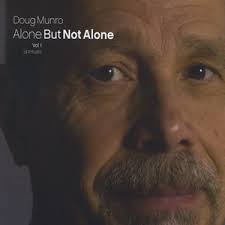
Daily Dose Of Jazz…
Douglas Anthony Munro was born July 9, 1953 in Yonkers, New York. He started his musical studies at age seven, taking drum lessons and by age fourteen, he was playing dances in Yonkers and New York City. At 20, he broke his back in a gymnastics accident, which ended his career as a drummer. However, in 1977 the 24 year old underwent a successful back surgery, and began playing guitar to pass the time during recovery
After his recovery he became a guitarist, performed locally and taught guitar lessons. In 1986 he released the LP Courageous Cats. and towards the end of the decade Doug met record producer Joe Ferry, and began a 25 year professional relationship. He would go on to divide his career into arranging, performing, teaching, and producing with Ferry. In 2004 he started a series of four Boogaloo recordings for Scufflin’ Records. The first, Boogaloo to Beck, featured Lonnie Smith, David “Fathead” Newman, and Lafrae Olivia Sci. He would go on to release to Brazilian jazz albums under the Big Boss Bossa Nova title.
The early Nineties saw Doug arranging and producing with Joe Ferry. Their first album, We Remember Pastorius, was a tribute to jazz bassist Jaco Pastorius. He would go on to co-produce and arrange a series of recordings for Shanachie Records. This period saw him delving into ska, receiving two Grammy nominations. In 1997 Munro added orchestrations to the original motion picture soundtrack for the Muhammad Ali documentary When We Were Kings which won the Academy Award for Best Documentary Film.
Munro continued to work on over 40 recording albums into the new millennium with Vitamin Records. He has produced lessons for Just Jazz Guitar, Premier Guitar, and TrueFire.com. He founded the jazz studies program in the Conservatory of Music at Purchase College in 1993, and served as the director of the program from 1993-2002. He retired in 2019 as Professor Emeritus and Director Emeritus of the Jazz Studies program at the Conservatory of Music at Purchase College.
Guitarist, arranger, producer, composer, author, and educator Doug Munro specializes in jazz, bebop, Brazilian jazz, jazz fusion, and gypsy swing. Since 1986 he has released over fifteen albums as a band leader and has appeared on over 75 recordings as a guitarist, sideman, producer, and arranger. He has been nominated for two Grammy Awards and was the recipient of two NAIRD Awards by the American Association of Independent Music.
More Posts: arranger,bandleader,composer,educator,guitar,history,instrumental,jazz,music,producer

KURT ROSENWINKEL
Kurt Rosenwinkel ~ Guitar, Eric Revis ~ Bass, Taylor Eigsti ~ Piano, Gregory Hutchinson ~ Drums
Kurt Rosenwinkel has been a distinct and prominent creative voice at the forefront of modern music for nearly three decades. The American multi-instrumentalist, composer, and producer has gained international recognition for his deft artistry and unabated individualism since he first appeared on the New York music scene in 1991. His legacy as the pre-eminent jazz guitar voice of his generation is plainly evident on his eleven albums as a leader, each one the inspiration for legions of musicians young and old across the globe.
Kurt’s aesthetic vision and multi-genre facility has caught the ear of some of modern music’s most prominent stars; collaborations with Eric Clapton, Q-tip, Gary Burton, Paul Motian, Joe Henderson, Brad Mehldau, and Donald Fagen are but a few highlights from a remarkably diverse and extensive catalog of over 150 sideman recordings. In the winter of 2016, Kurt formed the independent music label Heartcore Records with the focused intention of signing and promoting a new generation of musicians whose exacting standards match his own.
Actual Showtimes ~ 7:00 pm & 9:30 pm | Friday
Front Stage Table ~ $40.00/$20 minimum purchase required
General Admission ~ $30.00/$20 minimum purchase required
Students 17 & under ~ $20.00/$10 minimum purchase required
More Posts: adventure,album,club,genius,guitar,jazz,museum,music,preserving,restaurant,travel

JOHN PIZZARELLI
John Pizzarelli, the world-renowned jazz guitarist and singer, was called “Hip with a wink” by Town & Country, “madly creative” by the Los Angeles Times and “the genial genius of the guitar” by The Toronto Star. After his recent smash success with the Boston Pops, he was hailed by the Boston Globe for “reinvigorating the Great American Songbook and re-popularizing jazz.” And the Seattle Times called him “a tour de force” and “a rare entertainer of the old school.”
Using performers like Nat “King” Cole, Frank Sinatra and Joao Gilberto and the songs of composers from Richard Rodgers, George Gershwin to James Taylor, Antonio Carlos Jobim and Lennon & McCartney as touchstones, John Pizzarelli has established himself as one of the prime interpreters of the Great American Songbook and beyond, bringing to his work the cool jazz flavor of his brilliant guitar playing and singing. For Pizzarelli though, his hero and foundation was Nat “King” Cole and the comparison to his iconic trio is the highest of compliments. “I’ve always said in my concerts that Nat ‘King’ Cole is why I do what I do.” But Pizzarelli adds, “We aren’t trying to copy him. His sound was singular and inspired. I’ve always said we’re an extension, a 21st century version of what that group was.”
Showtimes:
7:00 pm | Thurs, Sun~$40.00, Fri, Sat~$50
9:00 pm | Thurs, Sun~$20.00, Fri, Sat~$50
$15 food/beverage minimum per person not included in ticket price.
More Posts: adventure,album,club,genius,guitar,jazz,museum,music,preserving,restaurant,travel

THE YELLOWJACKETS
The Yellowjackets formed in the late 1970’s as the backup band for guitarist Robben Ford. They recorded their first album together in 1980. Shortly after that recording, however, Ford decided to part ways and go in a different musical direction. As a result, the modern day Yellowjackets were formed — a trio with Russell Ferrante, Jimmy Haslip and Ricky Lawson. Since then, and with the addition of Bob Mintzer, the Yellowjackets have gained and maintained prominence as one of jazz’s most influential and loved groups.
The most recent addition to the band adds Australian bass player Dane Alderson in to the mix. With his exceptional rhythmic sensibility and natural disposition toward groove, Dane brings a new energy to the band and adds a youthful approach to the music.
Showtimes:
7:00 pm | Sat ~ $40.00, Sun ~ $30.00
9:00 pm | Sat ~ $40.00, Sun ~ $20.00
$15 food/beverage minimum per person not included in ticket price.
More Posts: adventure,album,bass,club,genius,guitar,jazz,museum,music,piano,preserving,restaurant,saxophone,travel

STANLEY JORDAN
In a career that took flight with immediate commercial success and critical acclaim, guitar virtuoso Stanley Jordan has consistently displayed a chameleonic musical persona of openness, imagination, versatility and maverick daring. Be it bold reinventions of classical masterpieces or soulful explorations through pop-rock hits, to blazing straight ahead jazz forays and ultramodern improvisational works—solo or with a group—Jordan can always be counted on to take listeners on breathless journeys into the unexpected.
Key to Jordan’s fast-track acclaim was his mastery of a special technique on the guitar’s fretboard. Instead of conventional strumming and picking, Jordan’s innovative “touch technique” is an advanced form of two-handed tapping. While a handful of other players were using similar techniques, Stanley’s fluid, multi-layered textures and sheer virtuosity raised the bar for excellence.
Showtimes:
7:00 pm | Thurs, Sun ~ $30.00, Fri, Sat ~ $35.00
9:00 pm | Thurs, Sun ~ $20.00, Fri, Sat ~ $35.00
$15 food/beverage minimum per person not included in ticket price.
More Posts: adventure,album,club,genius,guitar,jazz,museum,music,preserving,restaurant,travel


